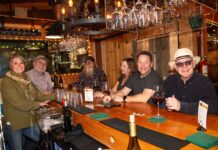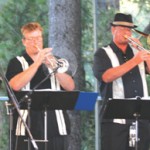
In the second issue of each month, RMRU contributes a column on mountain safety. This week, Lee Arnson has provided a first-person account of the harrowing rescue.
RMRU has just been called out for a helicopter rescue on the rock. I swing my truck into place below the Helipad at Keenwild and breathe a sigh of relief as I see Les Walker, one of our most capable technical rock rescuers, already deep in conversation with the technical flight officer.
A rock climber had taken a serious 40-foot or more fall onto a small ledge about 300 feet above Tahquitz’s base. He was initially unconscious and is now reporting severe head, neck and chest pain.
CAL FIRE flew in to assess, and deemed the situation too dangerous to approach with a larger helicopter and no high-angle rock experience. The decision was made to call in RMRU and the Riverside Sheriff Aviation Unit, but to use CDF’s litter and packaging system.
This will be the first time ever that we are sharing gear with CDF. Les and I kneeled down with their crew to receive a hands-on tutorial on the litter system. I’m impressed with its straightforwardness. The strapping system is efficient and will be an asset in the conditions we’re expecting on the rock. They supply us with a c-collar and additional medical supplies tailored to deal with the expected trauma the climber has suffered from his fall.
We’ll be going in loaded for bear, backpacks bulging with more than 60 pounds of equipment. We are fully geared to be in and out within the hour, or to stay for the next two days. Between us we have hundreds of feet of rope in case we need to do a full technical lower. Hopefully the helicopter will be able to pull us out, but assumptions can get you in trouble.
We board the A-star and within moments we’re surging into the air. With our huge packs Les and I are wedged into the small cabin like sardines. Manny, our TFO, balances himself outside on the skid, securely clipped into the helicopter with a bird’s eye view of the pine-covered ravines rushing by below.
We fly up near the massive face of the rock. Kevin puts us into a hover that seems impossibly close, blades spinning a mere 20 feet off of the rock. The courage and skill it takes to fly a mission like this are incredible. The wind pouring over the ridgeline and the rotor wash against the rock cause unpredictable conditions that even the best pilot can’t predict.
Les clips into the hoist and scoots past me towards the open door. Pilot Kevin holds position, while Manny lowers Les into a bushy scrub oak sprouting precariously out of the ledge. Les uses its branches to pull himself into relative safety and quickly anchors himself in.
As soon as Les unclips from the hoist, Kevin pulls the helicopter off to a safe distance. Underneath the thick overgrowth I can just make out Les greeting the subject and his wife. He immediately secures them safely to the face of the rock and then sets anchors for me. He looks up and waves to the copter to signal that he’s ready for me.
I drop smoothly into open air, the rotor wash reflected back from the rock buffeting my body. The ledge approaches quickly and I can see Les below me in the branches, leaning forward, ready to clip me in to our safety line.
Suddenly the world jerks, sways and drops!
The rock swings away from my view and I’m flying backward, wind whistling in my ears and pines rushing past below my feet.
A drastic change in the wind has hit the helicopter. The pilot’s only choice is to peel away from the rock or risk crashing. His quick action and skillful flying have saved us, but now I’m wildly swinging like a pendulum underneath the helicopter. Manny recognizes the risk and sets to work lowering the hoist at the apex of each swing to stop my upward momentum. Finally quieting my swing, he hoists me back up.
As I climb back into the helicopter, I give Manny the thumbs-up to let him know I’m good to go for another attempt.
Kevin sets the helicopter into a hover again. Out the door I go. This time the hoist goes smoothly and before I know it I’m landing deep inside the scrub. Les clips me into the safety line right away.
Once we are safely situated the helicopter edges back in to lower the CDF litter. We lean out from our anchors to grab it as it spins in the wind. With a wave and a nod Star-9 peels away. We make our way down onto the belay ledge, an area about the size of a large coffee table, with vertical rock on all sides and a sheer 300-foot drop off.
Les briefly introduces me to the subject and his wife. We immediately begin packaging him into the litter. It’s difficult work. The litter takes up the floor of the ledge. We are left perched on the edge of a sheer drop, leaning into our anchors while working to strap him in. Despite the warmth of the day the subject is shivering uncontrollably, a potential sign of dangerous hypovolemic (significant loss of blood and fluids) shock. I give him my coat before we tighten the three layers of webbing and buckles to secure him for the hoist.
We can’t hoist the litter through the thick shrub engulfing the ledge. We’ll have to slide the litter out into the open onto the face of the rock so that the hoist can reach the spider attached to the litter.
We set up a lower, with the amazingly calm wife acting as belay. As we slide him off the edge of the sheer drop, the litter tilts slowly forward and the subject blurts out; “I’m losing blood pressure, I’m going to faint.” His face goes slack. Les and I make eye contact. Oh man. We immediately start to raise the litter back up.
Les wedges his leg under the foot end of the litter to prop to it up while I work at the head end to level it out. I radio in a change of plan to the helicopter. We can’t leave the subject in a vertical position for long, so we will have to wait for the last minute to get him into position for the hoist.
I perch precariously at the end of my daisy chain anchor, reaching out as far as possible. Les has the litter still teetered on one leg as he stretches to reach for the hoist cable. The incredible rotor wash of the A-star hammers into me, feeling like it wants to blow me right off the rock. Les catches the hoist. I hold the spider up and clip it in.
The litter is now safely clipped to the hoist, but we need precise timing to get the slack to free it from our own system. Everything happens in quick succession. Les yells for slack over the pelting roar of the rotor wash, the subject’s wife gives us rope, Les unclips the litter while I give the helicopter the hand signal for a raise. The litter lifts and swings smoothly out and up away from the rock. Star-9 disappears over the forested ridge into the direction of the Keenwild helipad to transfer our subject to Mercy Air.
I smile and Les claps me on the shoulder, “Good job buddy!” We grin at each other. Before it even seems possible, the helicopter is hovering over us again for a pickup. One by one we are hoisted back to safety. It’s time to head back to La Casita for a celebration!











Wow….Great job guys! Awesome story!
Thank you so much for your work with RMRU.
Not sure how I missed this story but glad to read it now. May not have understood all the language but still felt clarity of what happened. Good to know we have the resources here on The Hill to take care of our own. Well done!